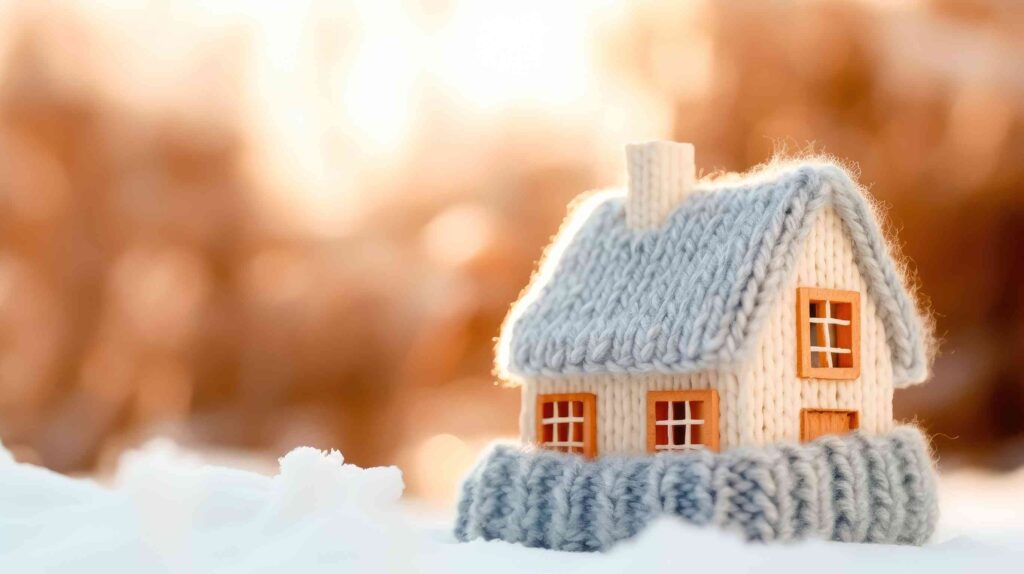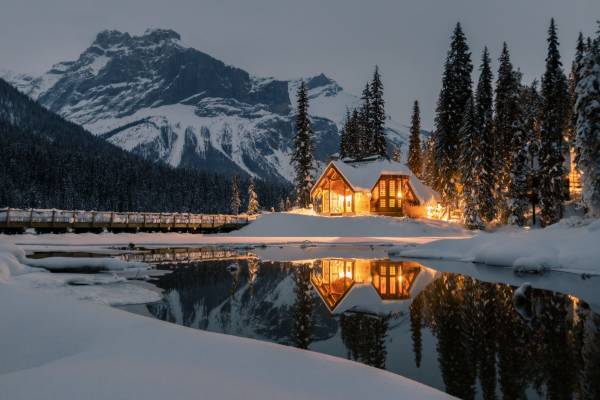
When the cold weather rolls around, most people’s minds turn to cosy evenings, knitwear, and hot drinks. However, if you’re a landlord, you may be more likely to associate the winter months with damp and disputes! But fear not; there’s plenty you can do to plan and prepare for any potential problems and help things run smoothly this winter.
In this article, we will explore some of the most common issues that landlords (and tenants) face as the cold sets in, offering actionable advice to pre-emptively tackle these problems and ensure a smoother, more comfortable winter for all.
Condensation, Damp, and Mould in Rental Properties
Unfortunately, damp problems are very common in UK homes. According to the English Housing Survey, around 904,000 homes in England had damp problems in 2021 – a figure which I’m sure is even higher in reality! One of the main reasons damp and mould problems are so common in this country is the age of the properties – the UK has some of the oldest housing stock in Europe! Whilst your rental property is more likely to have problems with damp and mould if it is older, these problems can also occur in new housing, particularly if tenants don’t help prevent it.
As well as being unsightly, living in a damp or mouldy property can be hazardous to your tenant’s health and potentially cause significant damage to your property if not resolved. Landlords are required by the law to ensure that rental properties are ‘fit for habitation’ and free from serious hazards – including damp and mould! If your tenants report a problem with damp or mould, you are legally responsible for addressing the problem. So, if you know your rental property is susceptible to becoming damp and mouldy during the winter months, this is a problem that you must take seriously.
Let’s find out what steps you can take to help reduce condensation, damp, and mould problems within your rental property.
Check-in with Tenants
Whilst you could schedule a property inspection, it is often more effective to contact tenants a couple of weeks after the first cold snap and ask if they’ve noticed any areas in the property that look damp, mouldy or where there is excess condensation. After all, many damp problems arise in hidden corners, behind furniture and curtains, so your tenants are likely to know best if there are any issues. Even if they haven’t noticed any problems, asking them to keep an eye out and alert you quickly if they spot any problems can help put it on their radar and make them more likely to report any future problems.
Perform Winter Property Maintenance Checks
Certain property maintenance tasks can help reduce the likelihood of your rental property succumbing to damp and mould. Taking the time to tick these off during the autumn months can help to keep damp problems at bay when the winter rolls around.
Important damp and mould-fighting property maintenance checks include:
- Clear the guttering.
- Check the condition of heating systems and internal pipes.
- Check the roof for missing, damaged, or slipped tiles.
- Reseal, paint, or repair damaged window frames.
- Insulate pipes and water tanks.
- Bleed the radiators.
Educate Tenants
Your tenants play a key role in minimising moisture within the property. Their daily activities and routines can have a huge impact on the level of moisture within the property. It’s important to educate tenants on the steps they can take to help reduce moisture and protect the property from damp and mould. Below, we’ve listed some key tips to provide tenants with. Ideally, you should provide them with a digital or paper copy of the advice, as it can be a lot to take in if you’ve not had to deal with it before.
- Keep the whole property heated to a warm, even temperature where possible.
- Air the property regularly by opening windows.
- Don’t put furniture against walls.
- Close the bathroom door when showering and open the bathroom window afterwards.
- Close the kitchen door when cooking and open a window.
- Use extractor fans if provided.
- Wipe condensation from windows.
Provide Solutions
If you know condensation is a problem in your rental property, you could provide tenants with solutions to help minimise the problem. If you know one of the bedrooms suffers from particularly bad condensation because it is on an outer wall, then providing tenants with a dehumidifier for that room could help prevent moisture from building up. Equally, if tenants are drying their clothes on the radiators, providing a tumble dryer could help reduce the moisture in the property. However, it’s important to note that both dehumidifiers and tumble dryers can be expensive to run, so if the electricity bill is not included in the rental price and tenants are forced to keep these appliances on to prevent mould, then you may need to support tenants with these costs. While these practical solutions may help with minor damp issues, they are not a substitute for addressing the underlying cause, particularly in more serious cases.
Make Improvements
If you’ve followed all the steps above and it’s just not cutting it, you and your tenants are still struggling to keep damp and mould at bay, then it’s time to consider improving your property to eliminate (or minimise) the problem. First, you’ll need to know the underlying cause of the problems, ranging from a missing roof tile to poor ventilation or inadequate insulation. If you’re unsure what the cause is, an expert can help you identify it. Whilst these improvements can be expensive, they are also necessary and can help to save you time, money, and hassle in the long term.

Issues with Heating the Property
When it’s freezing outside, everyone should be able to return to a warm and comfortable home at the end of a long day. During the winter, issues with heating the property can be a significant concern for both tenants and landlords as they can lead to discomfort, high energy bills, and exacerbate problems with damp and mould. Here are some potential challenges and solutions for landlords.
The Property is Difficult to Heat
If your tenants report that the property isn’t getting warm, even with the heating turned up high, this could be indicative of several issues, such as:
- Radiators need bleeding – If the property’s heating system hasn’t been used for a while, the radiators may need to be bled. This simple process releases trapped air, allowing hot water to fill every part of the radiator and warm the room more efficiently. Make sure you provide tenants with a radiator key to allow them to carry out this simple maintenance task themselves.
- Inefficient or broken heating system – It can be useful to time your rental property’s annual boiler and heating system maintenance and service to fall during the autumn to ensure that the heating system is working at its optimal capacity before the colder weather hits. A service will also help identify and rectify any issues that could reduce the system’s efficiency before they become problematic.
- Poor energy efficiency – Some properties are more difficult to heat than others. If your tenants are struggling to get warm even with the heating on full blast, then it is likely that your property’s energy efficiency needs to be improved. Upgrading insulation or installing new windows and doors can improve your property’s energy efficiency rating. While these may seem like expensive renovations, they should be viewed as a long-term investment as they will increase your property’s value, make it more attractive to potential tenants and reduce the risk of damp and mould problems.
Heating Disputes When the Heating Bill is Included in Rent
Some landlords include heating bills in the price of rent; this type of arrangement is particularly common in houses in multiple occupancy (HMOs). If you do have this arrangement, it is wise to include a fair usage policy in the tenancy agreement that outlines acceptable heating use and clarifies that excessive use could result in additional charges or adjustments to the rental agreement. It’s equally important to highlight such clauses and be transparent about their terms with your tenants from the start to avoid future disputes.
Challenges of the Holiday Season
As the Christmas decorations go up and festive tunes start to fill the air, some of the challenges of the holiday season can leave landlords feeling less than jolly.
From jingle-bell rock-outs that have the neighbours knocking, to silent nights interrupted by unexpected maintenance issues, let’s find out what seasonal scenarios landlords should plan and prepare for.
Noise Complaints
If your tenants’ festivities involve large gatherings and belting out Mariah Carey at midnight, you may receive noise complaints from the neighbours. A polite reminder about keeping the festive cheer to a considerate decibel usually resolves the issue.
Increased Domestic Disputes
More time at home during the holidays can mean your tenants get under each other’s feet, and domestic disputes become rife. If you become aware of any problems, a gentle nudge about communal harmony, as outlined in their tenancy agreement, usually helps to keep the peace and ensure the holiday cheer isn’t disturbed by unnecessary bickering.
Delays Reporting Maintenance Issues
Christmas is a busy time of year for most people, and many tenants go away or visit family for extended periods during the holiday season. Reporting damp problems or flickering lights may not be at the top of your tenants’ priority list during this time, or problems may even go unnoticed. Encouraging tenants to report issues promptly can help prevent small maintenance issues from becoming more significant problems.
Fire Hazards
The sight of your rental property aglow with festive light can be heartwarming, but remember, Christmas is also the worst time of year for fire safety. Christmas candles and electrical sockets overloaded with twinkly fairy lights are prime fire hazards. Encourage tenants to test their fire alarms before the festive season and remind them not to overload electrical sockets or leave candles unattended.
Excess Waste
After Christmas, your tenants’ bins are bound to be bulging with all the excess waste that seems synonymous with the festive season. Confusingly, waste collection services tend to operate on different days over Christmas, so it may be helpful to remind tenants of what days to put their bins out. If they miss the collection day, they risk attracting pests or creating sanitation issues.
We hope this article has prepared you with tips and advice for fostering a warm and well-maintained rental property this winter. Remember, when preparing your property for winter, you’re not just fighting off the cold or keeping tenants happy; you’re building long-lasting trust with your tenants and investing in the longevity of your property. Here’s to a season of preparedness, prevention, and prosperity!



